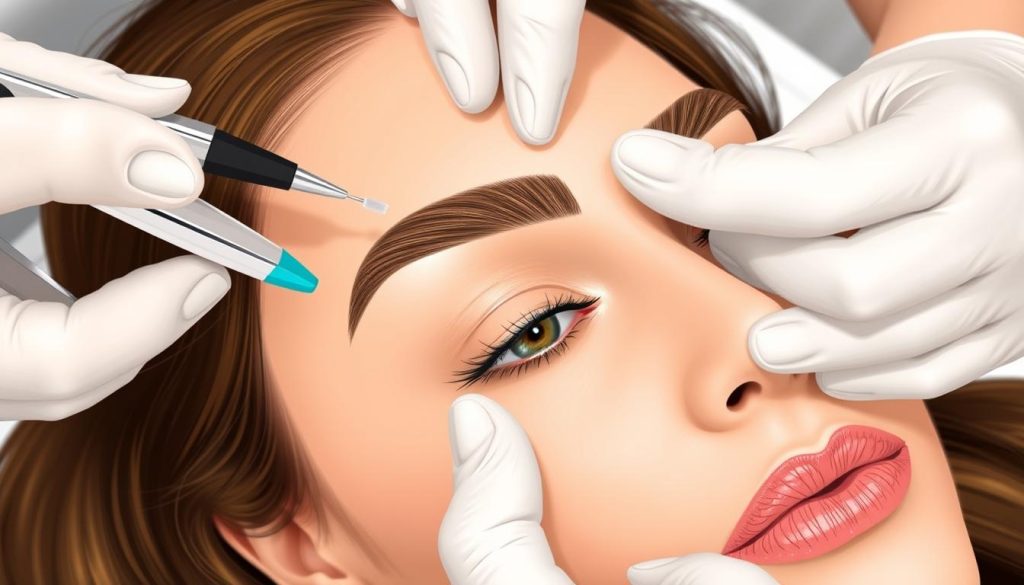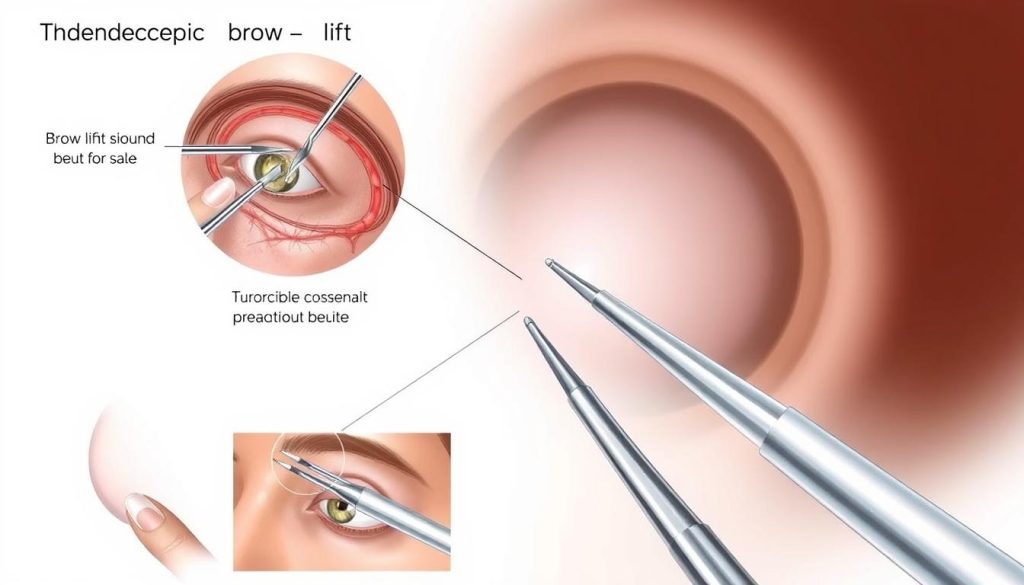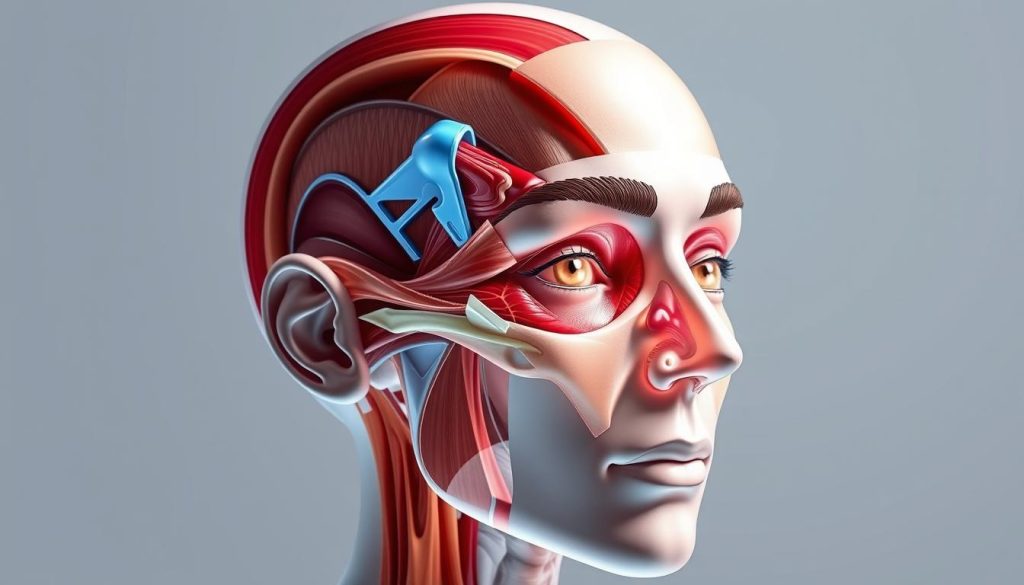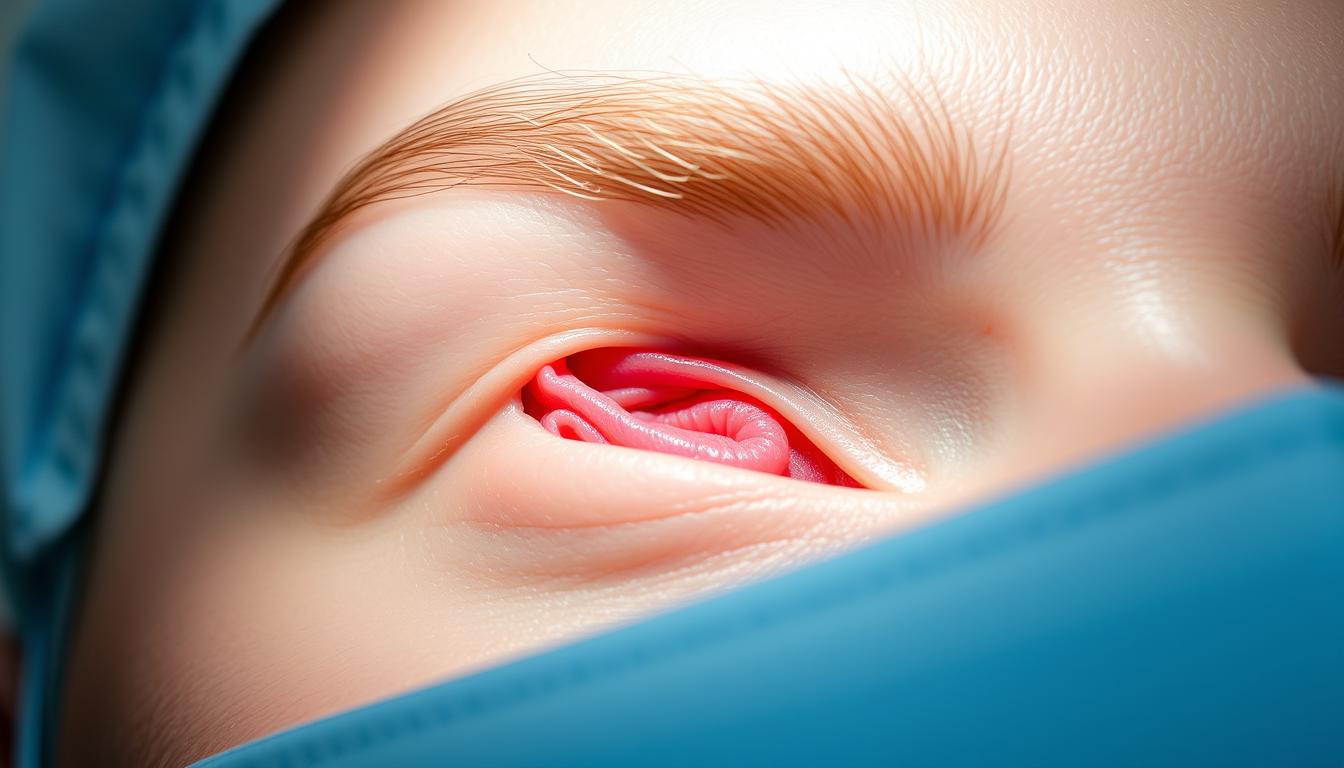A brow lift is a cosmetic surgical procedure that repositions the forehead to raise the brow, reducing wrinkles and giving a more youthful appearance. As individuals age, skin loses elasticity, and the accumulated effect of sun damage weakens skin, causing gravity to pull the brow down.
This comprehensive guide explores the various surgical techniques used in eyebrow lift incision procedures, providing detailed information for those considering this cosmetic enhancement. Modern surgical techniques have evolved to offer more targeted approaches with reduced recovery time and less visible scarring.
Key Takeaways
- Understanding the anatomical considerations and surgical planning involved in brow lift procedures is essential for achieving natural-looking results.
- Different incision techniques offer varying degrees of correction, recovery times, and scarring patterns.
- The goal of any lift procedure is to create a refreshed, alert appearance without an unnatural look.
- Surgical and non-surgical approaches to brow lifting have their advantages and limitations.
- Modern surgery techniques provide more targeted approaches with reduced recovery time.
Understanding Eyebrow Lift Surgery
For individuals looking to refresh their facial appearance, an eyebrow lift surgery can be a highly effective solution. This procedure is designed to address various concerns related to the eyebrows and forehead area.
What is a Brow Lift?
A brow lift is a surgical technique that elevates the eyebrows to create a more open and alert facial appearance. By repositioning the brow, this procedure can significantly improve the overall aesthetic of the face and eyes.
Signs You Might Need a Brow Lift
If you’re experiencing sagging brows, deep forehead wrinkles, or frown lines between your eyebrows, you might be a good candidate for a brow lift. These signs can make a person appear tired, angry, or concerned.
Benefits of Eyebrow Lift Procedures
The benefits of an eyebrow lift procedure are numerous. Some of the key advantages include:
- A more open, alert, and approachable facial appearance
- Reduced deep forehead wrinkles and frown lines
- Improved appearance of the upper face
- Enhanced self-confidence due to a more refreshed and youthful look
- The appearance of larger, more open eyes without directly altering the eyelids
By understanding the benefits and signs that indicate the need for a brow lift, individuals can make informed decisions about undergoing this procedure to improve their facial appearance and overall confidence.
Candidacy for Eyebrow Lift Surgery
To be a good candidate for an eyebrow lift, certain criteria must be met. The suitability of a patient for this surgery is determined by various factors, including their overall health, the condition of their brow, and their expectations from the procedure.
Ideal Candidates
Ideal candidates for an eyebrow lift are typically those who have noticeable brow ptosis or signs of aging in the forehead area. They should be in good physical health and have realistic expectations about the outcomes of the surgery. Most patients are between 40 and 70 years old, although younger individuals with premature aging or genetically heavy brows may also be considered.
Medical Considerations
Certain medical conditions can affect a patient’s eligibility for eyebrow lift surgery. It’s crucial for patients to disclose their full medical history to their surgeon. Factors such as previous surgeries, existing health conditions, and lifestyle habits like smoking are taken into consideration.
Age and Timing Factors
The timing of an eyebrow lift is critical. While there’s no specific age requirement, the procedure is usually considered when non-surgical treatments no longer provide satisfactory results. The longevity of the results varies, but most patients can expect their brow lift to last 5-10 years. Maintaining a healthy lifestyle can help prolong the results.
| Factor | Ideal Condition | Considerations |
|---|---|---|
| Age | 40-70 years | Younger patients with heavy brows or premature aging |
| Health | Good physical health | Disclosure of medical history required |
| Expectations | Realistic | Understanding the limitations of the lift |

Non-Surgical Eyebrow Lift Options

Non-surgical eyebrow lift techniques have gained popularity for their effectiveness and minimal downtime. These alternatives to surgical brow lifts offer a range of benefits, including reduced recovery time and fewer risks.
Botulinum Toxin (Botox) Injections
Botulinum toxin injections are a widely used non-surgical method for achieving a brow lift. By relaxing the muscles around the brow, Botox can help elevate the eyebrows and reduce the appearance of fine lines and wrinkles. The effect typically lasts for several months, depending on individual factors.
Soft Tissue Fillers
Soft tissue fillers, particularly those based on hyaluronic acid, can enhance the contour and volume of the eyebrows. They work by adding volume to strategic areas around the brow and temple region, creating a lifting effect. The results are immediate, though temporary, lasting around 6-12 months. Fillers can be used alone or in combination with neurotoxins for a more comprehensive non-surgical brow lift, often referred to as a “liquid brow lift.”
The most effective technique involves injecting high-viscosity, high-elasticity fillers deep along the superior orbital rim and lateral brow, creating a supportive platform that elevates the brow position. Temple hollowing often contributes to lateral brow descent, so addressing this area with fillers can provide additional lifting effects for the outer portion of the eyebrow.
Eyebrow Lift Incision Techniques
Understanding the various eyebrow lift incision techniques is essential for both surgeons and patients. The choice of technique significantly impacts the outcome and recovery of the brow lift procedure.
Trans-Blepharoplasty Approaches
Trans-blepharoplasty approaches to brow lifting involve making incisions during blepharoplasty (eyelid surgery) to access and modify the brow. This technique is beneficial for patients who require both eyelid and brow rejuvenation. It allows for a more subtle approach by utilizing existing incisions, potentially reducing visible scarring.
The trans-blepharoplasty approach can be particularly effective for addressing lateral brow ptosis. By accessing the brow through the upper eyelid incision, surgeons can reposition or remove tissue as needed, achieving a more youthful appearance.
Direct Brow Lift Incisions
Direct brow lift incisions involve making a cut directly above the brow. This technique is straightforward and allows for precise control over the brow’s position. It is particularly useful for patients with significant brow ptosis or asymmetry.
While the direct brow lift is effective, it carries the risk of visible scarring. However, for many patients, the benefits outweigh this risk, especially when the scar can be hidden within the brow’s natural crease.
Trans-Forehead Approaches
Trans-forehead approaches involve making incisions across the forehead, either within existing forehead creases or at the hairline. This technique provides direct access to the brow and forehead tissues, allowing for substantial improvement in brow position and forehead appearance.
- The mid-forehead lift technique is particularly suitable for men with significant forehead rhytids and higher hairlines.
- Trans-forehead techniques can be performed under local anesthesia with sedation, making them appropriate for patients who cannot tolerate general anesthesia.
- These approaches allow for direct excision of excess skin and modification of the frontalis muscle.
Recovery from trans-forehead approaches is typically shorter than from more extensive procedures like coronal lifts, with most patients returning to normal activities within 7-10 days.
Endoscopic Brow Lift Technique

The endoscopic brow lift technique has revolutionized the field of cosmetic surgery with its minimally invasive approach. This modern method allows surgeons to achieve desirable results with less scarring and faster recovery times compared to traditional techniques.
Procedure Steps
During an endoscopic brow lift, the surgeon makes several small incisions behind the hairline. Using a tiny camera and thin instruments, the surgeon repositions the muscles and lifts the underlying tissues of the forehead, removing excess fat and tissue as needed to create a more youthful brow.
The procedure typically involves general anesthesia to ensure patient comfort. The use of an endoscope enables precise modification of tissues while minimizing trauma to sensory nerves and blood vessels.
Advantages and Limitations
The endoscopic brow lift offers several advantages, including minimally invasive incisions that result in less scarring and numbness. It is particularly effective for patients with mild to moderate brow ptosis who require tissue repositioning.
- The endoscopic approach preserves hair follicles and hairline position, making it ideal for patients concerned about hairline changes.
- Despite its advantages, the endoscopic brow lift has limitations, including a steeper learning curve for surgeons and the requirement for specialized equipment.
- Some studies suggest that the longevity of results may be less than with more traditional approaches, particularly in patients with significant skin laxity or heavy brows.
Overall, the endoscopic brow lift technique is a valuable option for patients seeking to rejuvenate their forehead and brow area with minimal downtime.
Coronal and Trichophytic Brow Lift
The coronal and trichophytic brow lift methods offer distinct advantages for patients seeking forehead rejuvenation. These surgical techniques are designed to address various concerns related to the brow and forehead area.
Coronal Lift Procedure
A coronal brow lift involves making an incision behind the hairline, typically from ear to ear. This approach allows the surgeon to lift and reposition the tissues of the forehead, including the brow and frown lines. The coronal lift procedure is often used in conjunction with other facial surgeries, such as eyelid surgery, to achieve a more comprehensive facial rejuvenation.

Trichophytic (Hairline) Approach
The trichophytic brow lift, also known as a hairline brow lift, involves making an incision directly along the anterior hairline. This technique is particularly useful for patients with high foreheads, as it allows for precise control of hairline position and can actually lower a high hairline while lifting the brows. The trichophytic approach provides excellent access for muscle modification and can achieve significant and long-lasting elevation of the brows.
The trichophytic brow lift offers several benefits, including the ability to address two aesthetic concerns with one procedure: lowering a high hairline and lifting the brows. The incision is designed with an irregular or beveled edge that transects hair follicles at an angle, allowing hair to grow through the scar and improve its camouflage once healed.
Temporal and Mid-Forehead Lifts
The quest for effective brow lift techniques has led to the development of temporal and mid-forehead lifts, catering to diverse patient needs. These approaches have gained prominence due to their ability to address specific brow and forehead concerns.
Temporal Brow Lift Technique
The temporal brow lift technique focuses on elevating the lateral aspect of the brow, providing a more youthful appearance. This method involves minimal incisions and is less invasive compared to other brow lift techniques. It’s particularly effective for patients with lateral brow ptosis, offering a subtle yet significant improvement.
Temporal brow lifts are often performed in conjunction with other facial rejuvenation procedures, enhancing overall results. The technique requires precise knowledge of brow anatomy to achieve optimal outcomes.
Mid-Forehead Lift Approach
The mid-forehead lift utilizes incisions placed within deep horizontal forehead creases, making it suitable for individuals with significant forehead rhytids. This approach allows for direct access to the brow depressor muscles and precise removal of excess skin, providing substantial improvement in brow position and forehead appearance.
- The technique is especially effective for correcting medial and central brow ptosis.
- By placing incisions within existing forehead lines, the resulting scars can be well-camouflaged.
- Mid-forehead lifts provide long-lasting results with excellent control of brow position and shape.
As noted by experts,
“The mid-forehead lift is a valuable technique for patients with deep forehead lines, offering effective brow repositioning with acceptable scarring.”
Preparing for Eyebrow Lift Surgery
As the date of your eyebrow lift surgery approaches, it’s essential to prepare yourself for a smooth and successful procedure. This preparation involves several steps that can significantly impact your recovery and overall outcome.
Pre-Surgical Consultation
The initial step in preparing for your eyebrow lift surgery is a thorough pre-surgical consultation with your surgeon. During this consultation, discuss your expectations, medical history, and any concerns you may have. This meeting is crucial for creating a personalized plan tailored to your needs.
Medical Evaluations
Before undergoing eyebrow lift surgery, you will need to undergo certain medical evaluations to ensure you are fit for the procedure. These evaluations may include blood tests, physical examinations, and potentially other diagnostic tests as recommended by your surgeon. The goal is to identify any potential risks and mitigate them to ensure a safe recovery.
Lifestyle Adjustments Before Surgery
In the weeks leading up to your eyebrow lift surgery, several lifestyle adjustments are recommended to optimize healing and minimize complications. According to experts, “Smoking cessation is perhaps the most critical adjustment, as nicotine severely constricts blood vessels, impairs tissue oxygenation, and can lead to poor wound healing, tissue death, and increased infection risk.”
Other adjustments include limiting alcohol consumption, avoiding blood-thinning medications, and maintaining a healthy, balanced diet. Preparing your home environment and arranging for assistance during the initial recovery period are also crucial. By making these adjustments, you can significantly enhance your recovery experience over time.
Recovery and Aftercare
Recovering from a brow lift surgery requires careful attention to aftercare instructions to maximize the benefits of the procedure. A well-planned recovery process helps minimize potential complications and ensures optimal results.
Immediate Post-Operative Care
Immediately after the surgery, it’s essential to follow the surgeon’s instructions for post-operative care. This may include keeping the head elevated, applying ice packs to reduce swelling, and avoiding strenuous activities. Patients should also be aware of the potential risks and complications, such as bruising, swelling, or infection.
Timeline for Recovery
The recovery timeline for a brow lift surgery varies from person to person, but most patients can expect to return to their normal activities within 1-2 weeks. During this time, it’s crucial to attend follow-up appointments with the surgeon to monitor the healing process and address any concerns.
Long-Term Care for Optimal Results
To maintain the results of a brow lift, patients should adopt a healthy lifestyle, including wearing sunscreen daily, eating a balanced diet, and not smoking. A comprehensive skincare regimen, including retinoids and antioxidants, can also help maintain skin quality and elasticity. By following these tips, patients can enjoy the benefits of their brow lift for 5-10 years or more.
- Protect your skin from the sun by using broad-spectrum SPF30+ sunscreen daily.
- Maintain a healthy lifestyle by eating a nutrient-rich diet and avoiding smoking.
- Consider periodic non-surgical treatments, such as neurotoxin injections or fillers, to maintain optimal results.
By combining a healthy lifestyle with proper aftercare, patients can enjoy a rejuvenated appearance and maintain the benefits of their brow lift for years to come.
Choosing the Right Eyebrow Lift Technique for You
Selecting the ideal eyebrow lift technique is a nuanced process that requires careful consideration of various factors, including facial anatomy, degree of brow ptosis, hairline position, and personal aesthetic goals. When it comes to facial cosmetic surgery, understanding the most suitable brow lift procedure is crucial for achieving the desired outcome.
The endoscopic brow lift has become the gold standard for many patients, particularly younger individuals with mild to moderate brow ptosis who desire minimal scarring and a natural result. However, patients with high or receding hairlines may benefit more from direct or mid-forehead approaches, as these techniques avoid further hairline elevation and can even lower the hairline in some cases.
Other factors to consider include the degree of skin laxity, forehead wrinkles, and the patient’s willingness to accept visible scarring. Men typically require different aesthetic considerations than women, with preservation of a stronger, straighter brow rather than the arched contour often desired by female patients. The recovery timeline is also an important practical consideration, with less invasive techniques offering shorter recovery periods.
Combining eyelid surgery (blepharoplasty) with a brow lift can provide comprehensive rejuvenation of the upper face. Ultimately, the decision should be made collaboratively between patient and surgeon after thorough discussion of goals, expectations, and the relative advantages and limitations of each technique for the individual’s specific situation.
By carefully evaluating these factors and considering the expertise of a qualified plastic surgeon, patients can make an informed decision about the most appropriate brow lift technique to achieve their desired outcome.
FAQ
What is the typical recovery time for a brow lift surgery?
The recovery time for a brow lift surgery can vary, but most patients can expect to return to their normal activities within two to three weeks. However, it may take several months for the final results to be fully visible.
Will a brow lift surgery leave noticeable scars?
The visibility of scars depends on the surgical technique used. Techniques like the endoscopic brow lift and temporal brow lift are designed to minimize scarring. The trichophytic approach involves an incision made along the hairline, which can be hidden by hair regrowth.
Can a brow lift be performed under local anesthesia?
While some brow lift procedures can be performed under local anesthesia with sedation, others may require general anesthesia. The choice of anesthesia depends on the complexity of the procedure and the patient’s comfort level.
How long do the results of a brow lift last?
The results of a brow lift can last for several years. However, the aging process continues, and the brows may eventually begin to droop again. Maintenance treatments, such as Botox, can help prolong the results.
Are there any non-surgical alternatives to a brow lift?
Yes, there are non-surgical alternatives, including botulinum toxin injections and soft tissue fillers. These treatments can provide temporary improvements in the appearance of the brow area.
What are the risks associated with brow lift surgery?
As with any surgical procedure, brow lift surgery carries risks, including scarring, infection, and nerve damage. It’s essential to discuss these risks with a qualified plastic surgeon to understand the potential complications.
Can I undergo a brow lift if I have had previous eyelid surgery?
Having had previous eyelid surgery does not necessarily preclude you from undergoing a brow lift. However, it’s crucial to consult with a plastic surgeon to assess your individual situation and determine the best course of action.
